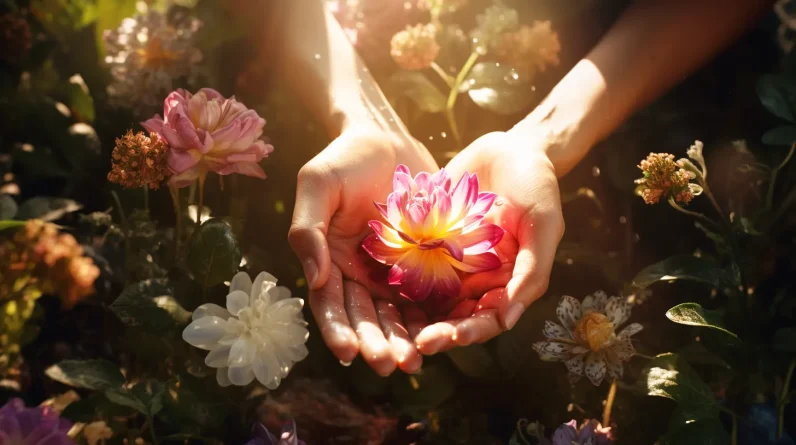
In the hustle and bustle of modern life, finding moments of peace and tranquility can seem like an elusive quest. However, imagine if there was a way to cultivate inner peace simply by connecting with nature.
Mindful gardening offers just that – a metaphorical oasis amidst the chaos, where one can nurture both plants and their own well-being.
In this article, we will explore the transformative power of mindful gardening and how it allows us to forge a deep connection with nature while cultivating inner peace within ourselves.
The Benefits of Mindful Gardening
The benefits of mindful gardening can be observed through increased feelings of inner peace and connection with nature. Engaging in the practice of mindful gardening provides a multitude of healing benefits for individuals seeking to reduce stress and find solace in their surroundings.
One significant benefit of mindful gardening is its capacity to promote stress reduction. The act of tending to plants, observing their growth, and nurturing them creates a sense of focus and calmness that alleviates the pressures of daily life. Research has shown that spending time in nature can lower cortisol levels and decrease anxiety, leading to an overall sense of well-being. Mindful gardening allows individuals to escape from the hustle and bustle of modern society, providing a sanctuary where they can retreat and recharge.
In addition to stress reduction, mindful gardening fosters an intimate connection with nature. By engaging all senses – touching soil, smelling flowers, hearing birds chirping – gardeners develop a deeper appreciation for the natural world around them. This heightened awareness leads to a sense of interconnectedness with plants, animals, and ecosystems. Through this connection, individuals often experience a profound sense of peace as they recognize their place within the larger web of life.
Ultimately, engaging in mindful gardening offers individuals an opportunity for self-discovery and personal growth through connection with nature. It serves as a pathway towards inner peace by providing healing benefits and reducing stress levels. In this fast-paced world filled with constant demands, cultivating mindfulness through gardening allows individuals to find freedom from everyday stresses while fostering a deep connection with the natural world around them.
Creating a Sacred Space for Reflection
Creating a sacred space for reflection involves the establishment of an environment that promotes introspection and contemplation. This peaceful retreat allows individuals to find solace in nature, fostering a deep connection with the natural world and facilitating inner peace.
To create a sacred space for reflection, consider incorporating the following elements:
Natural Surroundings: Choose a location surrounded by trees, flowers, or other natural elements. These provide a sense of calm and tranquility that can enhance introspective practices.
Quietude: Seek out a quiet area where external distractions are minimized. This allows for undisturbed contemplation and encourages mindfulness.
Symbolic Objects: Incorporate objects that hold personal meaning and inspire self-reflection. These could include stones, statues, or artwork that evoke emotions or memories.
By creating this sacred space, individuals have the opportunity to step away from their daily routines and immerse themselves in a sanctuary of peace. In this tranquil environment, they can explore their thoughts and emotions more deeply, gaining insights into their inner selves.
Through mindful gardening practices within this sacred space, individuals can cultivate not only beautiful gardens but also inner peace and connection with nature.
Practicing Mindfulness in Plant Care
Practicing mindfulness in plant care involves engaging in attentive and deliberate actions while tending to plants, promoting a heightened sense of awareness and focus. Mindful watering is one aspect of this practice that encourages individuals to be fully present in the act of nurturing their plants. Rather than mindlessly pouring water onto foliage, practitioners take the time to observe and connect with the plant’s needs. They carefully assess soil moisture levels, considering factors such as temperature, humidity, and sunlight exposure. By doing so, they develop a deeper understanding of their plants’ specific requirements.
Mindful pruning is another vital component of this practice. Instead of simply trimming away overgrown branches without thought or purpose, practitioners approach pruning with intentionality and sensitivity. They take the time to study the plant’s growth patterns and identify areas that need attention. With each cut made, mindfulness practitioners consider the impact on both the plant’s health and aesthetic appeal.
Through mindful gardening practices like mindful watering and pruning, individuals can cultivate a profound connection with nature. This connection allows them to not only enhance their gardens but also find inner peace through their interactions with plants. By approaching these tasks with compassion, insightfulness, and introspection, practitioners can experience a sense of freedom as they engage in an activity that fosters harmony between themselves and the natural world around them.
Connecting with the Natural Rhythms of the Seasons
Aligning with the natural rhythms of the seasons allows individuals to establish a harmonious relationship with the environment and optimize their gardening efforts. By embracing seasonal mindfulness practices, gardeners can tap into nature’s healing power and deepen their connection with the earth.
Here are five ways in which connecting with the natural rhythms of the seasons can evoke emotion and enhance one’s gardening experience:
Embracing change: Just as the seasons transition seamlessly from one to another, individuals can learn to embrace change in their own lives. This mindset allows for personal growth and adaptation.
Finding balance: Observing how nature finds balance between growth and rest throughout different seasons can inspire individuals to seek balance in their own lives.
Cultivating patience: Witnessing plants grow slowly over time teaches us patience and reminds us that good things come to those who wait.
Letting go: As autumn arrives, trees gracefully shed their leaves, reminding us of the importance of letting go of what no longer serves us.
Embracing renewal: Spring brings forth new life, symbolizing hope, renewal, and fresh beginnings. This reminder encourages individuals to embrace opportunities for growth and transformation.
By aligning with nature’s rhythm, we not only optimize our gardening efforts but also find inner peace through a deeper connection with ourselves and our surroundings. Seasonal mindfulness practices enable us to tap into nature’s healing power, offering freedom from stress and fostering a sense of tranquility within.
Cultivating Gratitude and Mindful Awareness
Cultivating gratitude and mindful awareness allows individuals to appreciate the beauty of their surroundings and develop a deeper understanding of their environment. Gratitude practices involve intentionally acknowledging and expressing appreciation for the gifts that nature provides, such as the vibrant colors of flowers or the soothing sound of flowing water. By cultivating gratitude, individuals can shift their focus from what is lacking to what is present in their lives, fostering a sense of contentment and fulfillment.
Mindful breathing is another essential aspect of cultivating gratitude and mindful awareness in gardening. By focusing on the sensation of breath entering and leaving the body, individuals can anchor themselves in the present moment and cultivate a sense of calmness. This practice enables gardeners to fully immerse themselves in the act of gardening, observing each movement with intentionality and precision.
When individuals engage in gratitude practices and incorporate mindful breathing into their gardening routine, they foster an intimate connection with nature. They become attuned to the subtleties of growth cycles, weather patterns, and ecological relationships within their garden ecosystem. Through this heightened awareness, they not only gain a deeper understanding but also develop a profound respect for nature’s intricate balance.
By connecting with nature through gratitude practices and mindful breathing techniques, individuals experience a profound sense of freedom. They transcend daily worries by immersing themselves in the present moment while genuinely appreciating all that surrounds them. Ultimately, cultivating gratitude and mindful awareness in gardening allows individuals to nurture inner peace while forging stronger connections with both themselves and the natural world around them.
Frequently Asked Questions (FAQs)
What are some common mindfulness practices that can be incorporated into a daily gardening routine?
Mindful breathing and sensory awareness are common mindfulness practices that can be incorporated into a daily gardening routine. These practices help cultivate inner peace by fostering a deep connection with nature and promoting a sense of freedom.
How can mindful gardening help reduce stress and anxiety?
Mindful gardening techniques for beginners, such as focusing on the present moment and observing nature’s beauty, can help reduce stress and anxiety. The role of mindfulness in connecting with nature promotes a sense of calmness and tranquility.
Are there any specific plants or flowers that are particularly beneficial for promoting mindfulness and inner peace?
Incorporating mindfulness into gardening routines offers numerous benefits, including promoting inner peace and connection with nature. Creating a mindful gardening space involves best practices such as incorporating sensory elements, prioritizing simplicity, and fostering a sense of tranquility.
Can mindful gardening be practiced in small spaces such as apartment balconies or indoor gardens?
Mindful gardening can be practiced in small spaces like apartment balconies or indoor gardens. It offers benefits for physical health, such as reduced stress and improved well-being. Techniques like container gardening and vertical gardening are suitable for limited spaces.
How can gardening help improve our overall mental and emotional well-being?
Gardening therapy, or the practice of using gardening as a therapeutic tool, has been shown to have numerous benefits for mental and emotional well-being. It can reduce stress, improve mood, increase self-esteem, promote relaxation, and provide a sense of purpose and fulfillment.
Conclusion
In conclusion, mindful gardening offers us a serene pathway to inner peace and connection with nature. By creating a sacred space for reflection, we invite stillness and contemplation into our lives.
Through the practice of mindfulness in plant care, we cultivate a deep sense of awareness and sensitivity towards the needs of our green companions. Connecting with the natural rhythms of the seasons allows us to witness the beauty of growth, decay, and rebirth.
Ultimately, this journey instills within us gratitude and a profound understanding of our place within the intricate tapestry of life.





